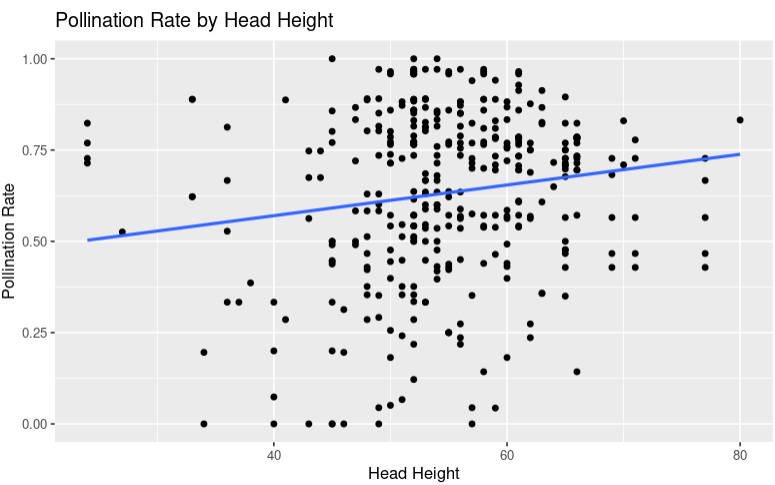Echinacea Project 2023
Undeclared, Carleton College, 2026
Pronouns: He/him
Research Interests
I want to study biology and learn more about plant science.
Statement
I am from Houston, Texas.
In my spare time I like to play the trumpet and play games.


Echinacea Research Project
Introduction
The goal of my externship was a research project about Echinacea where I asked two questions and then conducted a study. The first question is does having taller head height increase pollination rates by insects in Echinacea. My second question is does having more heads increase or decrease pollination by insects in Echinacea.
Background
Echinacea is insect-pollinated mainly by bees and other studies I found have shown that in plants like C. behrii and V. thapsus taller heads are more likely to be pollinated because they are more visible to pollinators. Since we don’t know if head height plays a similar role in Echinacea I am conducting this study to see if there is any correlation between head height and pollination rates in Echinacea.
Another study I found saw more heads leading to greater pollination rates. However, Echinacea is self-incompatible, meaning it can not pollinate itself, unlike the plants in that study so its possible that if an insect stays at a single Echinacea plant with more heads instead of moving on to other plants it could actually hurt its pollination rate. This led me to my second research question to determine if there is a correlation between number of heads and pollination rates in echinacea.
Methods
I used data from a sample of about 229 heads that were put through a data collection process aimed at separated and analyzing the achenes in Echinacea heads. Achenes are the fruit that contain seeds in Echinacea heads so by analyzing if they contain seeds or not we can gather pollination data for this experiment. In the first step of the process we cleaned the heads for achenes. Then we rechecked our first count for accuracy and scanned the achenes into the computer for counting. Lastly, we randomized our achenes, separated them to be x-rayed, and classified them to see which achenes contained seeds giving us our pollination rates.
Question 1
After the data collection process the data was compiled into spreadsheets that were uploaded into R. I put the data on a scatterplot with head height vs pollination rate to create a regression line that had a positive correlation but was also very scattered. To see if that correlation was significant I conducted a linear regression analysis and found that it was significant so taller head height does seem to be related to higher pollination rates.

Question 2
I used boxplots to visualize this data with number of heads for an individual Echinacea plant vs average pollination rate and the pollination rate seems to go up as number of heads increase, the opposite of what I was expecting with self-incompatibility. I then conducted an ANOVA test and found that the difference in average pollination rate by number of heads was not significant so number of heads does not seem to have an effect on pollination rates.

Conclusion
My results gave a positive correlation between head height and pollination rate and no correlation between number of heads and average pollination rate. However, a big limitation to my study was the sample size, especially for question two. Only having one data point for the 5 and 7 heads categories could have a large effect on the data. Lastly, since this was an observational study we can only infer correlation not causation so someone conducting an actual experiment would be a good direction to go in the future.
Acknowledgements and Bibliography
Bibliography-
- Dickson, C.R., Petit, S. Effect of individual height and labellum colour on the pollination of Caladenia (syn. Arachnorchis) behrii (Orchidaceae) in the northern Adelaide region, South Australia. Plant Syst. Evol. 262, 65–74 (2006). https://doi.org/10.1007/s00606-006-0472-3
- LORTIE, Christopher J., and Lonnie W. AARSSEN. “The Advantage of Being Tall: Higher Flowers Receive More Pollen in Verbascum Thapsus L. (Scrophulariaceae).” Écoscience 6, no. 1 (1999): 68–71. http://www.jstor.org/stable/42901102.
- Ohashi K, Yahara T. Effects of variation in flower number on pollinator visits in Cirsium purpuratum (Asteraceae). Am J Bot. 1998 Feb;85(2):219. PMID: 21684905.
- Wagenius S, Lyon SP. Reproduction of Echinacea angustjfolia in fragmented prairie is pollen-limited but not pollinator-limited. Ecology. 2010 Mar;91(3):733-42. doi: 10.1890/08-1375.1. PMID: 20426332.
Thanks to Wyatt and Abby for helping me with data collection, Stuart for helping me develop ABTs and to the National Science Foundation for providing funding.
Materials that were used for my project can be found in the filepath: ~/Dropbox/ccExterns2023/conlanRamirez

Leave a Reply